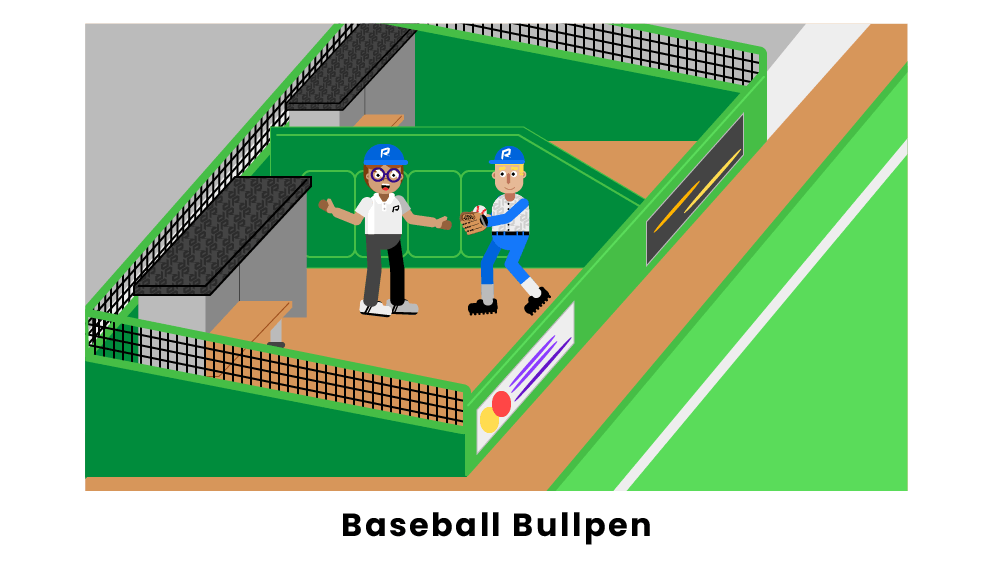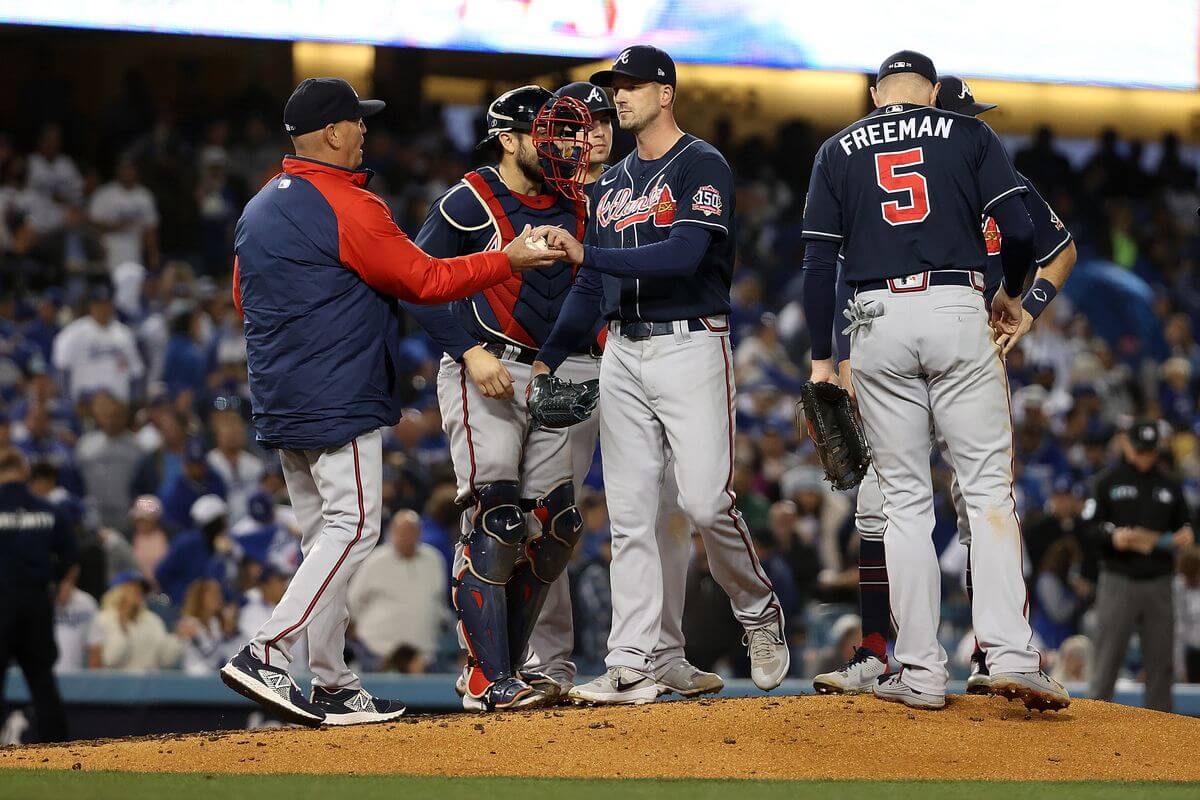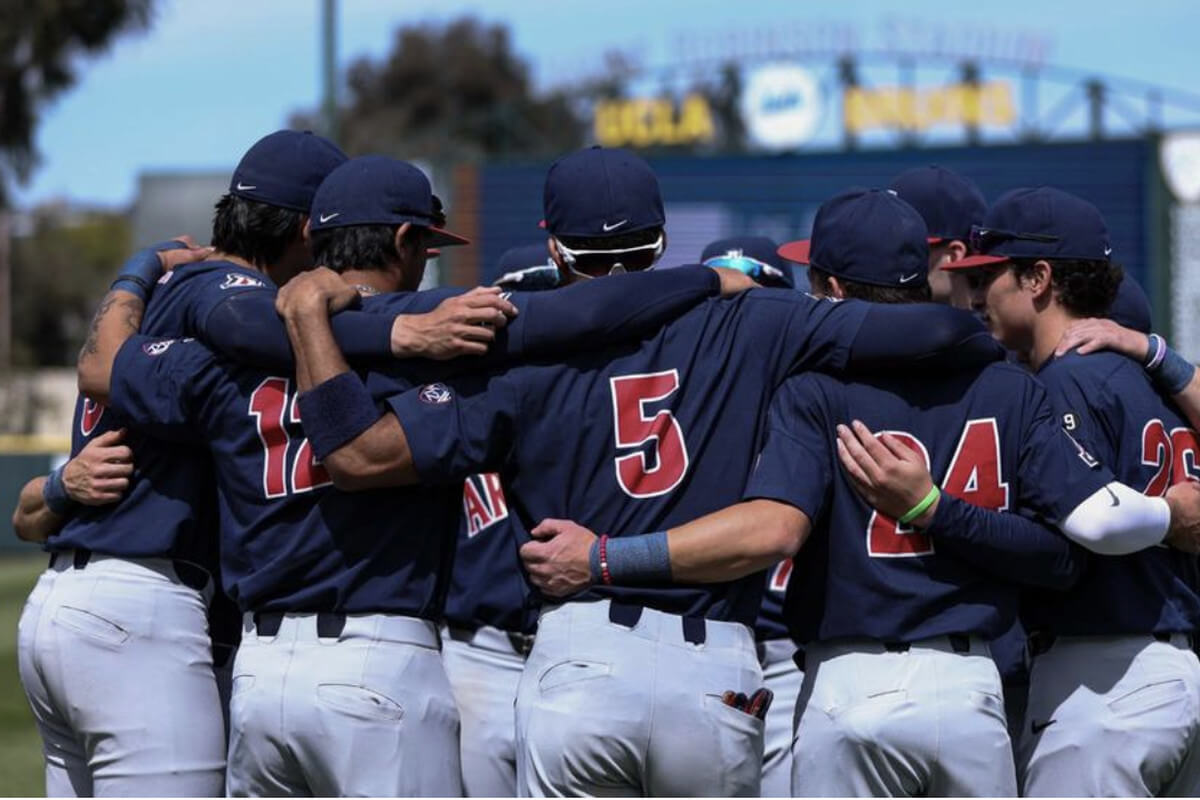If you are new to baseball, you might wonder what a bullpen is and what it does. A bullpen is a term used in baseball to refer to the group of relief pitchers who warm up and wait for their turn to take over for the starting pitcher. In this article, we will explore the concept of a bullpen in baseball, shedding light on its role, importance, and strategic significance in America’s favorite pastime.
Key Takeaways
- A bullpen is a group of relief pitchers who warm up and wait for their turn to take over for the starting pitcher.
- The role of the bullpen is to provide relief and support to the starting pitcher, maintaining the team’s performance throughout the game.
- A strong bullpen can directly influence game outcomes and contribute to team success.
- Building an effective bullpen involves player selection, roles and responsibilities, and tactical decisions.
- Managing the bullpen is an art that involves decision-making, factors influencing pitching changes, and the manager’s role in maximizing bullpen effectiveness.
Understanding the Bullpen: Definition and Purpose

The bullpen in baseball is a designated area in the field where pitchers warm up and wait for their turn to enter the game. It consists of a group of relief pitchers who are brought in for the starting pitcher to replace them when necessary, providing relief and support to maintain the team’s performance throughout the game.
The purpose of the bullpen is to ensure that the team always has fresh, capable pitchers ready to enter the game and maintain the team’s competitive edge. It also allows for more strategic flexibility, as managers can make pitching changes based on situational matchups and tactical considerations, such as lefty-righty matchups.
The bullpen in baseball is explained as a critical element of the game, providing a key strategic advantage to teams that use it effectively. With the rise of more specialized relievers, the bullpen has become an essential part of the game, with managers carefully constructing and managing their bullpen to maximize its effectiveness.
Evolution of the Bullpen: From Starters to Relievers

In the early days of baseball, starting pitchers were expected to complete the entire game. However, as the sport evolved, so did the strategies involved in managing a team. One of the most significant changes was the rise of the bullpen and the transition from starters to relievers.
This shift began in the 1920s when managers started using relief pitchers to close out games that were previously won by starting pitchers. By the 1950s, teams began to use specialized relief pitchers, known as closers, to finish games.
The use of relievers continued to increase in the 1960s and 1970s, as managers realized the benefits of having fresh pitchers to face batters. This led to the development of the setup man, a relief pitcher who would be used in the eighth inning to set up the closer for the ninth inning.
Today, the use of relievers has become a standard part of baseball strategy, with many teams relying on a combination of starters and relievers to win games. This has also led to the emergence of the “opener,” a relief pitcher who starts the game and pitches one or two innings before being replaced by another pitcher.
Starters vs Relievers
While starters were once expected to pitch the entire game, relievers are used for shorter periods, typically pitching one inning or less. Starters are often selected based on their ability to pitch effectively for several innings, while relievers are chosen based on their ability to get batters out in short bursts.
Starters and relievers also have different pitch repertoires. Starters typically have a wider variety of pitches, including breaking balls and changeups, while relievers often rely primarily on fastballs.
Transition from Starters to Relievers
There are several factors that have contributed to the transition from starters to relievers in baseball. One of the main reasons is the increased focus on pitch count and injury prevention. Starting pitchers who throw too many pitches or pitch too often are at a greater risk of injury, so managers have started using relievers more frequently to keep their starters fresh.
Another factor is the increased importance of matchups in baseball strategy. Managers often use relievers to exploit platoon advantages, bringing in left-handed pitchers to face left-handed batters, for example. This can be especially effective in high-pressure situations with runners on base.
In addition, the rise of statistical analysis, or sabermetrics, has led to a greater emphasis on the importance of pitching performance in specific situations. This has led to more specialized roles for relievers, such as the closer and setup man, who are used in specific game situations depending on the score and inning.
The Role of the Bullpen: Providing Relief and Support

The bullpen in baseball plays a crucial role in providing relief and support to the starting pitcher, ensuring the team’s performance throughout the game.
At the start of a game, the starting pitcher takes on the responsibility of throwing as many pitches as they can while limiting runs scored by the opposing team. However, as the game progresses, the starting pitcher can become fatigued or lose their effectiveness, which is where the bullpen comes in.
In this scenario, the bullpen is called upon to provide relief by pitching for the remaining innings of the game. The relievers coming from the bullpen have a significant impact on the game’s outcome, and they must be able to maintain the team’s position and shut out the opposing team.
The role of a bullpen in baseball is not limited to providing relief only. A strong bullpen can also provide support for the starting pitcher by taking on specific hitters or getting out of high-pressure situations.
In addition to providing relief and support, the bullpen also has a strategic role in the game. Relief pitchers are often used to pitch only to particular batters or in specific situations, such as during the ninth inning with a lead.
“The bullpen is an essential part of any successful baseball team. It provides support and relief to the starting pitcher while also serving as an essential strategic asset,” says John Smith, an experienced baseball coach.
In short, the bullpen plays a vital role in maintaining the team’s performance and contributing to game outcomes. A strong bullpen can provide relief, support the starting pitcher, and play a strategic role in the game.
Importance of a Strong Bullpen: Impact on Game Outcomes
It’s no secret that a strong bullpen can make or break a baseball team’s success. From closing out games to providing essential relief for a fatigued starting pitcher, the bullpen is a critical component of any winning strategy.
When a bullpen is firing on all cylinders, teams can rest assured that they have a reliable and effective support system in place. On the other hand, a weak bullpen can lead to disastrous consequences, including blown leads, lost games, and missed opportunities for victory.
The impact of a strong bullpen on game outcomes cannot be overstated. In fact, statistical analysis shows that teams with a strong bullpen are much more likely to win games and advance to the postseason. For example, in the 2019 season, teams with a lead after the 7th inning went on to win 86.4% of their games. This underscores just how essential a strong bullpen is for securing victories.
Moreover, a strong bullpen can also have a psychological impact on the opposing team. When a team knows that they are facing a formidable bullpen, it can deflate their confidence and reduce their chances of mounting a comeback. Conversely, a weak bullpen can embolden the opposing team and leave them feeling optimistic about their chances of victory.
In short, the importance of a strong bullpen in baseball cannot be overstated. Whether you’re a fan or a coach, it’s essential to understand and appreciate the critical role that the bullpen plays in game outcomes. By prioritizing the development of a strong bullpen, teams can improve their chances of success and cement their place in baseball history.
Building an Effective Bullpen: Strategies and Considerations

A strong bullpen is crucial for a baseball team to succeed. Building an effective bullpen involves several considerations, including player selection, roles, and tactical decisions.
Bullpen Strategies
There are several bullpen strategies that a team can use to maximize their effectiveness in different game situations.
- Matchup-based strategy: This strategy involves selecting pitchers based on their strengths and weaknesses against specific batters. Managers can use this strategy to exploit favorable matchups and improve their chances of getting outs.
- The “closer” role: The closer is a specialized reliever who is responsible for pitching the final inning(s) of a game when the team has a small lead. This strategy can be effective in high-pressure situations, but it requires a strong closer and careful management.
- The “fireman” role: This strategy involves using a reliever in high-pressure situations, regardless of the inning or score. This can be effective when the game is on the line and requires a pitcher who can handle the pressure.
Considerations for Bullpen Construction
When constructing a bullpen, several factors should be taken into consideration.
| Factor | Description |
|---|---|
| Player skillset | Each pitcher has unique strengths and weaknesses that must be considered when selecting them for the bullpen. For example, some pitchers may have a strong fastball, while others may have a devastating curveball. |
| Roles and responsibilities | Different pitchers have different roles in the bullpen, such as the closer, setup man, and long reliever. Each role requires a different skillset and approach. |
| Team needs | The team’s overall needs should be considered when constructing a bullpen. For example, if the team has a strong starting rotation, they may not need as many long relievers. |
Tactical Decisions
Effective bullpen management requires making strategic decisions during the game.
“It’s not just about the pitcher’s performance, it’s also about matchups, the score, and the inning. Managers must consider all of these factors when making pitching changes to maximize their team’s chances of success.”
Additionally, managers must be aware of the fatigue levels of their pitchers and avoid overusing them, which can lead to injuries and decreased effectiveness in the long run.
By considering these factors and making tactical decisions, a team can build and manage an effective bullpen that can contribute to their overall success.
Bullpen Management: The Art of Making Decisions

Managing the bullpen in baseball is an art that requires a combination of skill, experience, and intuition. The manager must make decisions that balance the need to provide relief and support for the starting pitcher while considering the game situation, matchups, and the strengths and weaknesses of individual relievers.
One of the key factors influencing bullpen management is the pitch count and performance of the starting pitcher. If the pitcher has a high pitch count or is struggling with control, the manager may need to call on the bullpen earlier than planned. Conversely, if the pitcher is dominant and has a low pitch count, the manager may opt to let them pitch deeper into the game.
“Bullpen management is definitely a challenge,” says Tampa Bay Rays manager Kevin Cash. “You’re trying to put guys in the best position to succeed, but you’re also trying to win a game.”
In addition to pitch count, the manager must consider game situations when making decisions in the bullpen. For example, if the game is tied in the late innings, the manager may call on their top reliever or closer to shut down the opposing team’s offense. Alternatively, if the team is trailing, the manager may opt to bring in a middle reliever to provide multiple innings of relief and keep the game close.
Matchups are another key consideration in bullpen management. Managers will often bring in a reliever with a specific skillset to face a particular batter or group of batters. For example, a left-handed reliever with a good slider may be brought in to face a left-handed batter who struggles against sliders.
The manager’s role in bullpen management goes beyond just making pitching changes. They must also consider how to maximize the effectiveness of their relievers. This includes managing workload, providing rest days, and ensuring that pitchers are prepared for their roles and responsibilities.
The Impact of Bullpen Management on Game Outcomes
The decisions made in the bullpen can have a significant impact on game outcomes. Bringing in the wrong pitcher at the wrong time can lead to a momentum shift in favor of the opposing team. Conversely, making the right decision can swing the game in the team’s favor and lead to a win.
“Bullpen management is a huge part of the game,” says Houston Astros pitcher Ryan Pressly. “You have to have confidence in your guys, and the manager has to have confidence in us.”
Building trust between the manager and the relievers is crucial to effective bullpen management. When relievers feel supported and empowered, they are more likely to perform at their best and help the team win.
Bullpen Usage and Game Situations: Navigating Complex Scenarios

Using the bullpen effectively is a crucial aspect of any successful baseball team. Navigating game situations in the bullpen demands careful analysis of various factors and strategic decision-making to maximize a team’s chances of winning.
Understanding Bullpen Usage in Baseball
The primary role of the bullpen is to provide relief and support to the starting pitcher, with the goal of maintaining the team’s performance throughout the game. Bullpen usage varies depending on numerous factors, including the score, game situation, and pitching matchups.
It’s essential to use the bullpen strategically to avoid overtaxing pitchers and to exploit matchups, especially with left-handed and right-handed batters. Managers must also consider the workload of individual pitchers and the team’s upcoming schedule when making decisions.
Using the Bullpen Effectively
One significant factor in using the bullpen effectively is the concept of “bridging the gap,” which refers to the process of preserving a lead or keeping a game close until a team’s closer can take over. Managers must balance pitching changes with the need to maintain pitcher stamina and avoid overexertion that could lead to injuries or poor performance.
Another key consideration is how to handle high-pressure moments, such as clutch situations or extra innings. These scenarios require a different strategy than standard innings, and managers must consider the strengths and weaknesses of individual pitchers to make the best decisions.
Navigating Complex Scenarios
Effective bullpen usage also involves navigating complex scenarios, such as matchups between hitters and pitchers. Coaches must analyze various factors, including hitter tendencies, pitch types, and the location of previous pitches to select the optimal pitcher for the situation.
Another critical factor is the use of the closer, who specializes in closing games in the final inning. The closer typically has a specific role in the bullpen, and managers must decide when and how to deploy this player effectively.
Conclusion
In conclusion, understanding the concept of a bullpen in baseball is vital for any team’s success. As we have explored, the bullpen serves a crucial purpose in providing relief and support to the starting pitcher, maintaining the team’s performance throughout the game.
The Importance of a Strong Bullpen
Furthermore, having a strong bullpen can directly impact game outcomes, as we have seen in many high-pressure moments. Teams with ineffective bullpens can often struggle to maintain leads or comebacks, leading to disappointing losses. On the other hand, teams with strong and reliable bullpens can present a formidable challenge to opponents, giving them a significant edge.
Building an Effective Bullpen
To build an effective bullpen, teams must consider various strategies and factors, such as player selection, roles and responsibilities, and tactical decisions. The art of managing the bullpen also plays a crucial role in maximizing effectiveness, as the manager must navigate complex game situations and make critical decisions.
Understanding the Bullpen
Ultimately, to truly understand baseball, one must understand the bullpen and its role in the game. With this knowledge, players, coaches, and fans alike can gain a deeper appreciation for America’s favorite pastime and the strategic nuances that make it so captivating.
FAQ
What is a bullpen in baseball?
A bullpen in baseball refers to an area on the field where relief pitchers warm up and await their turn to enter the game.
What is the purpose of a bullpen?
The purpose of a bullpen is to provide relief and support to the starting pitcher. When the starting pitcher’s performance declines or when a strategic decision is made, a relief pitcher from the bullpen is called upon to replace them.
How has the bullpen in baseball evolved?
The bullpen in baseball has evolved from traditional starters pitching complete games to specialized relievers who are brought in for specific situations. This transition has been driven by factors such as pitch count management, increased focus on matchups, and the desire to optimize pitching performances.
What role does the bullpen play in baseball?
The bullpen plays a key role in providing relief and support to the starting pitcher. They aim to maintain the team’s performance throughout the game, ensuring that the opposing team’s scoring is minimized and that their team remains competitive.
Why is having a strong bullpen important in baseball?
A strong bullpen is important in baseball because it can directly impact game outcomes. The ability to shut down opponents in crucial moments can swing the momentum in favor of the team with the stronger bullpen, increasing their chances of winning.
What strategies should be considered when building an effective bullpen?
When building an effective bullpen, important strategies to consider include player selection, defining roles and responsibilities, and making tactical decisions based on matchups and game situations. These factors contribute to the overall effectiveness and success of the bullpen.
How is the bullpen managed in baseball?
Managing the bullpen in baseball involves making decisions regarding pitching changes, considering factors such as pitch count, game situation, and the skills and strengths of individual pitchers. The manager plays a crucial role in maximizing the effectiveness of the bullpen.
How is the bullpen utilized in different game situations?
The bullpen is utilized in various game situations, including high-pressure moments, matchups against specific opposing hitters, and in the concept of the closer, who is typically the team’s top relief pitcher and is brought in to close out games. Effective bullpen usage is crucial in navigating these complex scenarios.








